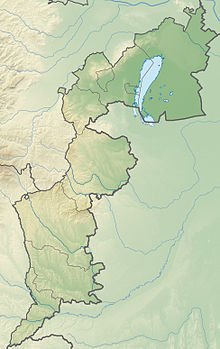Seewinkel
The area east of Lake Neusiedl in Burgenland is called Seewinkel .
Location and landscape
In the past, only the area of the places Podersdorf am See , Apetlon and Illmitz Seewinkel was mentioned, as these were enclosed at an angle by the former L-shaped extension of the lake. The area northeast was called Heideboden and southeast Hanság . However, these two regional names are hardly used anymore due to the long- standing isolation of the region through the border with Hungary ( Iron Curtain ).
Today, pars pro toto , Seewinkel means the entire Austrian region east of Lake Neusiedl. This includes the places Jois , Weiden am See , Gols , Mönchhof , Halbturn , Frauenkirchen , Sankt Andrä am Zicksee , Andau , Tadten , Wallern im Burgenland and Pamhagen . The region is characterized by extensive wine-growing areas , other areas are cultivated by urban communities (such as the Urbarialgemeinde Apetlon ) or large estates. In the first half of the 20th century, there was a series of widely ramified agricultural railways for the transport of agricultural goods, which made the connection to the Neusiedler Seebahn . Mainly grain, sugar beets, reeds and products made from them were transported. Only small remains of the route can be seen in the area.
Nature and climate
Particularly noteworthy are the swamps and the 40 or so lakes , which are very salty due to the lack of natural runoff. These lacquers have a length of up to 3 km and a width of 1 km and are only approx. 0.5 m deep, the largest is the long lacquer . Some of them dry up completely in summer. One of the largest is the Zicksee , which is also used for healing purposes with a spa in Sankt Andrä am Zicksee. Many of the other paints are protected. Accordingly, there is also a very rare salt flora.
The area is characterized by the Pannonian climate . It is relatively mild and has little precipitation (less than 600 mm per year) and very windy. With around 2000 hours per year, the Seewinkel is also the region in Austria with the most sunshine. The area is the westernmost salt steppe in Eurasia and averages just 117 m above sea level. A. With these characteristics, the Seewinkel is an atypical region for Austria with flora and fauna that are rarely found in Austria.
The region is located in the Neusiedler See-Seewinkel National Park and was already a Ramsar area and partially protected by the WWF . Since 2001 the area around the lake has been part of the UNESCO cultural landscape of Fertő / Neusiedler See .
Puszta landscape near the Lange Lacke
Darscho (Warmsee)
The South Russian tarantula lives in Seewinkel.
Atriplex intracontinentalis is threatened with extinction in Austria.
The rare Klein-Salzmelde grows in the soda lakes in Seewinkel and turns red in autumn.
In the more common large salt report , the leaves remain green.
The Pannonia-Glasmalz in Seewinkel differs genetically from similar clans on the seashore.
The salt trident appears absent -mindedly in the Seewinkel.
The Salzsteppen wormwood occurs in Austria only in the Seewinkel and in some places in the Marchfeld .
The Pannonia salt aster gives the paintwork colorful accents.
In thick-leaf goosefoot , the stems and perigone often turn purple.
The fern-leaved real yarrow usually has pink petals .
The thorn grass often covers the bottom of the lakes.
The Neusiedlersee salt plumes, also known as ziggrass, often occur on sandy soda soils.
Web links
Individual evidence
- ↑ A special feature of the Seewinkel: The "agricultural or field railways" In: Atlas Burgenland: Railways. (Retrieved June 10, 2017).
-
^ Johann Witz: The agricultural railways in the Seewinkel (horse tram Albrechtsfeld). In: Railway. ISSN 0013-2756 ZDB -ID 162227-4 . Born in 1968, issue 12, pp. 220-221 (approx. 12 km, from St. Andrä near Frauenkirchen to today's Albertkazmerpuszta in Hungary, built after World War I, discontinued in 1956).
Johann Witz: The field railway in Wallern. In: Railway. Born in 1969, issue 6, pp. 95–96 (approx. 1916 to 1945).
Hans Witz: The Agricultural Railway Frauenkirchen. In: Railway. Born in 1972, issue 1, p. 6 (after World War I until around 1956).
Johann Witz: The field railway in Pamhagen. In: Railway. Born in 1971, issue 7, p. 101 (1912 to approx. 1945, 60 cm gauge, horse and diesel operation, approx. 6–8 km to the Apetloner Meierhof).

















